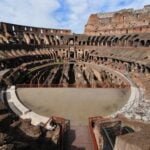Italy is renowned for its efficient and extensive rail network, making train travel a popular and convenient mode of transportation for locals and tourists alike. One question that often comes to mind is, “How fast does Italy train travel?” The answer lies in the country’s commitment to high-speed trains that whisk passengers across the picturesque landscapes at impressive speeds.
The history of Italian high-speed trains is a fascinating tale of technological advancement and innovation. From the development of sleek and aerodynamic trains to the implementation of cutting-edge infrastructure, Italy has been at the forefront of high-speed rail systems. These trains not only offer speed but also comfort and reliability, making them a preferred choice for many travelers.
One notable example is the Frecciarossa train, known for being the fastest train in Italy with impressive top speeds that rival those of its European counterparts. Serving major cities like Milan, Rome, and Venice, this high-speed train offers a smooth and swift journey that allows passengers to cover long distances in a fraction of the time compared to traditional rail services.
The introduction of such trains has revolutionized travel within Italy and bolstered its reputation as a leader in modern railway technology.
History of Italian High-Speed Trains
Italy has a rich history when it comes to high-speed trains, with a network that has evolved significantly over the years. The development of high-speed trains in Italy can be traced back to the introduction of the Frecciarossa service in 2008. This marked a significant milestone for Italian train travel, as it offered passengers the opportunity to travel at unprecedented speeds across the country.
Compared to other countries in Europe, Italy’s high-speed trains have made remarkable progress in terms of speed and efficiency. The Frecciarossa, operated by Trenitalia, is known for its top speeds of up to 186 mph (300 km/h), making it one of the fastest trains in Europe. This puts Italy among the top contenders when it comes to high-speed rail travel on the continent.
Advancements and Innovations
In recent years, Italy has continued to invest in its high-speed rail infrastructure, introducing new technologies and innovations to further enhance the speed and comfort of train travel. With ongoing projects aimed at expanding high-speed lines and improving connections between major cities, Italy is set to further solidify its position as a leading destination for fast and efficient train travel in Europe.
Comparison With Other Countries
When comparing Italian high-speed trains with those of other European countries like France, Germany, and Spain, Italy holds its own in terms of speed and connectivity. While each country may have its own unique advantages and challenges when it comes to train travel, Italy’s commitment to innovation and efficiency has allowed it to establish itself as a key player in the realm of high-speed rail across Europe.
The Frecciarossa Train
Here are some key details about the Frecciarossa train:
- Top Speed: The Frecciarossa can reach speeds of up to 300 km/h (186 mph), allowing passengers to cover long distances in a relatively short amount of time.
- Routes: The Frecciarossa train serves various routes connecting major Italian cities such as Milan, Rome, Florence, Naples, Venice, and more. These trains offer both standard and business class seating options, catering to different preferences and budgets.
- Amenities: Passengers traveling on the Frecciarossa can enjoy comfortable seating, free Wi-Fi, power outlets at every seat, onboard dining services with a wide selection of food and beverages, as well as dedicated areas for families and passengers with reduced mobility.
Overall, the Frecciarossa train exemplifies Italy’s commitment to modernizing its railway system and providing efficient transportation options for travelers. With its impressive speed and convenience, it is no wonder that this high-speed train is a preferred choice for many passengers looking to explore the beauty of Italy. Whether you’re visiting iconic landmarks or venturing off the beaten path, the Frecciarossa offers a seamless way to experience all that Italy has to offer.
Regional Trains in Italy
Regional trains play a crucial role in connecting smaller cities and towns in Italy, providing essential transportation options for both locals and tourists. While high-speed trains like the Frecciarossa offer rapid connections between major cities, regional trains cater to the more remote areas of the country. These trains offer a slower but scenic way of traveling through Italy, allowing passengers to take in the beautiful landscapes and charming villages along the way.
Speed of Regional Trains
Compared to high-speed trains, regional trains in Italy operate at a slower pace. On average, these trains travel at speeds ranging from 50 to 70 kilometers per hour, making frequent stops at various stations along their route. While this may not be as fast as high-speed alternatives, regional trains provide an affordable and convenient option for travelers looking to explore the less touristy parts of Italy.
Connecting Smaller Cities and Towns
One of the biggest advantages of regional trains is their ability to connect smaller cities and towns that may not be easily accessible by other means of transportation. These trains serve as a lifeline for local communities, allowing residents to commute for work or leisure while also providing visitors with a glimpse into the authentic charm of rural Italy. Traveling on regional trains offers a unique opportunity to experience the local culture and traditions that make each destination special.
Factors Affecting Train Speed
Italy offers a comprehensive railway network that connects major cities, smaller towns, and picturesque countryside regions. However, the speed at which trains travel in Italy can vary due to several factors. One of the key factors that affect the speed of trains in Italy is track conditions.
The quality and maintenance of railway tracks play a crucial role in determining how fast trains can travel. Well-maintained tracks allow for smoother rides and higher speeds, while deteriorating or outdated tracks may require trains to operate at reduced speeds for safety reasons.
Another significant factor that influences train speed in Italy is weather conditions. Adverse weather such as heavy rain, snow, or high winds can impact the efficiency and safety of train operations. In cases of inclement weather, train operators may need to implement speed restrictions to ensure passenger safety and prevent accidents. Additionally, extreme temperatures can also affect train speed, as heat waves or cold snaps may cause issues with infrastructure or rolling stock.
Furthermore, the type of train and its design can impact how fast it travels on Italian railways. High-speed trains like the Frecciarossa are designed for maximum efficiency and speed, allowing them to reach top speeds of up to 186 mph (300 km/h).
On the other hand, regional trains serve shorter distances and make more frequent stops, resulting in slower overall travel times. Understanding these various factors that influence train speed in Italy can help passengers better plan their journeys and manage expectations based on the type of service they choose.
| Factors Affecting Train Speed | Data |
|---|---|
| Track Conditions | Impact how fast trains can travel |
| Weather Conditions | Adverse weather can lead to speed restrictions |
| Train Type and Design | High-speed trains vs regional trains |
Comparison With Other European Countries
Italy is renowned for its efficient and extensive train network, offering travelers a convenient and scenic way to explore the country. But how fast does Italy train travel compared to other European countries like France, Germany, and Spain? Let’s take a closer look at the speed of trains in Italy compared to its neighbors.
In terms of high-speed trains, Italy has made significant strides in recent years with the introduction of their high-speed rail service called Frecciarossa. These trains can reach speeds of up to 300 km/h (186 mph), allowing passengers to travel between major cities such as Rome, Milan, Florence, and Naples in record time. The Frecciarossa trains have certainly placed Italy on par with its European counterparts when it comes to high-speed rail travel.
When comparing the speed of Italian trains with those in France, Germany, and Spain, it is important to consider factors such as track infrastructure and geography. While France’s TGV trains hold the current world record for the fastest wheeled train reaching 574.8 km/h (357 mph), Italy’s Frecciarossa offers competitive speeds for travel within the country.
Germany’s ICE trains also provide efficient high-speed connections between major cities, while Spain’s AVE trains offer a similar level of speed and comfort for travelers on their network.
- Italy: Frecciarossa trains up to 300 km/h
- France: TGV trains reaching 357 mph
- Germany: ICE trains offering high-speed connections
- Spain: AVE trains providing fast travel options
Overall, while each country may have its own unique approach to high-speed rail travel, Italy certainly holds its own when it comes to offering fast and efficient train services for both domestic and international travelers. As advancements in train technology continue to evolve across Europe, it will be interesting to see how Italy further enhances its already impressive train network in the coming years.
Future of Train Travel in Italy
Italy has been at the forefront of high-speed train travel in Europe, with its Frecciarossa trains being some of the fastest and most efficient in the region. The future of train travel in Italy seems promising, with potential improvements and advancements in technology that could further increase the speed and efficiency of rail transportation in the country.
One key aspect that could contribute to faster train travel in Italy is the continued investment in infrastructure, including upgrading rail tracks and implementing new signaling systems.
One exciting development on the horizon is the introduction of even faster high-speed trains in Italy. With advancements in train technology, there is a possibility of trains traveling at speeds higher than those currently achieved by the Frecciarossa trains. This could significantly reduce travel times between major cities in Italy, making train travel an even more attractive option for commuters and tourists alike.
In addition to speed, future improvements in train technology could also focus on increasing sustainability and reducing environmental impact. By investing in eco-friendly solutions such as electric or hydrogen-powered trains, Italy can lead the way in green transportation within Europe. These advancements not only benefit passengers through faster and more efficient travel but also contribute to a cleaner and more sustainable future for all.
| Train Type | Top Speed |
|---|---|
| Frecciarossa | 300 km/h |
| Potential Future High-Speed Train | Above 300 km/h |
Tips for Traveling on Italian Trains
Italy is renowned for its efficient and extensive train network, making train travel an essential mode of transportation for both locals and tourists. The high-speed trains in Italy have significantly reduced travel times between major cities, making it a convenient option for those looking to explore the country. One of the fastest trains in Italy is the Frecciarossa, which reaches top speeds of up to 300 km/h, allowing passengers to reach their destinations quickly and comfortably.
When it comes to regional trains in Italy, while they may not be as fast as the high-speed counterparts, they play a crucial role in connecting smaller towns and cities that may not be easily accessible by other means of transportation. These regional trains offer travelers a glimpse into the picturesque countryside of Italy, allowing them to enjoy a more leisurely pace of travel while still experiencing the charm of the country.
In conclusion, train travel in Italy offers a convenient and efficient way to explore this beautiful country. By understanding the various factors that can impact train speed, such as track conditions and weather, travelers can better prepare for their journeys.
As advancements continue to be made in train technology, we can expect even faster and more comfortable travel options in the future. Whether you are taking the high-speed Frecciarossa or hopping on a regional train to discover hidden gems off the beaten path, traveling by train in Italy is an experience not to be missed.
Frequently Asked Questions
What Is the 200 MPH Train in Italy?
The 200 MPH train in Italy is called the Frecciarossa, which translates to “Red Arrow.” It is a high-speed train that operates on several routes in Italy, reaching speeds of up to 300 km/h (186 mph).
What Are the Fastest Train Lines in Italy?
Some of the fastest train lines in Italy include the Frecciarossa, Frecciargento, and Frecciabianca services. These trains connect major cities like Rome, Milan, Venice, Florence, and Naples at high speeds, making it convenient for travelers to move from one city to another.
Is Train Travel Easy in Italy?
Train travel in Italy is relatively easy and efficient due to the extensive rail network that connects major cities and regions. Trains are a popular mode of transportation for both locals and tourists because they offer comfortable seating and convenient schedules.
Travelers can easily navigate through Italy by train using services like Trenitalia or Italo to reach their destinations quickly and comfortably.

I’m a passionate traveler, writer, and Italophile. My fascination with Italy’s history, art, and culture has led me on countless adventures across the Italian landscape. Through “I Live Italy,” I share my love for this extraordinary country and aims to inspire others to explore its boundless beauty.





